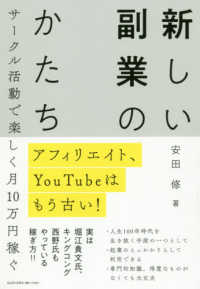- ホーム
- > 洋書
- > 英文書
- > History / World
Full Description
With contributions written by leading experts in the field, this volume explores the dialogue between Archaic and Classical Greek epigrams and their readers. The authors examine questions surrounding the identity of the speakers and the addressees. They also discuss the spatial, religious, historical and political contexts of epigram, as well as aspects of intertextuality, poetic variation and the creation of epigrammatic sub-genres. Collectively the volume demonstrates that the dominant view of epigram as a genre that became literary and artistic only in the Hellenistic period has to be revised. Archaic and Classical Greek epigrams did not simply serve the objects they describe but also demonstrate a high degree of aesthetic and literary achievement. This volume breaks new ground in the study of the genre and is important for scholars of classics, archaeology, epigraphy and papyrology.
Contents
Introduction Manuel Baumbach, Andrej Petrovic and Ivana Petrovic; Part I. Contextualisation; Section 1. Speaking and Reading: The Dialogue between Epigram and Passerby: 1. Speaker and addressee in early Greek epigram and lyric Thomas A. Schmitz; 2. The passerby in Archaic and Classical epigram Michael A. Tueller; 3. Voice in sepulchral epigrams: some remarks on the use of first and second person in sepulchral epigrams and a comparison with lyric poetry Gert Vestrheim; Section 2. Art and Viewing: The Spatial Context: 4. Epigrams in Archaic art: the 'Chest of Kypselos' Barbara E. Borg; 5. The Callimachus monument on the Athenian Acropolis (CEG 256) and Athenian commemoration of the Persian Wars Catherine M. Keesling; 6. 'Dialectics at a Standstill': Archaic kouroi-cum-epigram as I-Box Katharina Lorenz; Section 3. Epigram and Performance: The Religious Context: 7. Life in a line. A reading of dedicatory epigrams from the Archaic and Classical periods William D. Furley; 8. Observations on the dedicatory and sepulchral epigrams and their early history Catherine Trümpy; Section 4. Propaganda and Memorial: The Historical and Political Context: 9. Epigrams on the Persian Wars: monuments, memory and politics Carolyn Higbie; 10. True lies of public epigrams Andrej Petrovic; Section 5. Generic and Literary Contexts: The Rise and Reception of Epigramatic Subgenera: 11. Heroic epitaphs of the Classical age. The Aristotelian Peplos and beyond Kathryn Gutzwiller; 12. The origin of epigrams on 'Speaking Objects' Rudolf Wachter; Part II. Literarization - From Stone to Book; Section 1. Losing Context: Intertextuality and Poetic Variation: 13. Language and interpretation in Greek epigram Richard Hunter; 14. Typologies of variation on a theme in Archaic and Classical metrical inscriptions Marco Fantuzzi; Section 2. Inventing Contexts: Ecphrasis and Narration: 15. Epigram as narration Ewen Bowie; 16. Ecphrasis in fits and starts? Down to 300 BC Jon Steffen Bruss; Bibliography; Indices.








